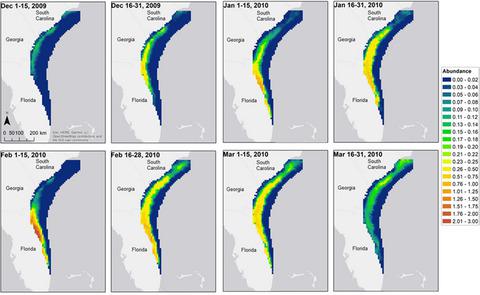当前位置:
X-MOL 学术
›
Ecol. Evol.
›
论文详情
Our official English website, www.x-mol.net, welcomes your
feedback! (Note: you will need to create a separate account there.)
An open spatial capture–recapture model for estimating density, movement, and population dynamics from line-transect surveys
Ecology and Evolution ( IF 2.3 ) Pub Date : 2021-05-03 , DOI: 10.1002/ece3.7566 Timothy A Gowan 1, 2 , Nathan J Crum 1 , Jason J Roberts 3
Ecology and Evolution ( IF 2.3 ) Pub Date : 2021-05-03 , DOI: 10.1002/ece3.7566 Timothy A Gowan 1, 2 , Nathan J Crum 1 , Jason J Roberts 3
Affiliation

|
The purpose of many wildlife population studies is to estimate density, movement, or demographic parameters. Linking these parameters to covariates, such as habitat features, provides additional ecological insight and can be used to make predictions for management purposes. Line-transect surveys, combined with distance sampling methods, are often used to estimate density at discrete points in time, whereas capture–recapture methods are used to estimate movement and other demographic parameters. Recently, open population spatial capture–recapture models have been developed, which simultaneously estimate density and demographic parameters, but have been made available only for data collected from a fixed array of detectors and have not incorporated the effects of habitat covariates. We developed a spatial capture–recapture model that can be applied to line-transect survey data by modeling detection probability in a manner analogous to distance sampling. We extend this model to a) estimate demographic parameters using an open population framework and b) model variation in density and space use as a function of habitat covariates. The model is illustrated using simulated data and aerial line-transect survey data for North Atlantic right whales in the southeastern United States, which also demonstrates the ability to integrate data from multiple survey platforms and accommodate differences between strata or demographic groups. When individuals detected from line-transect surveys can be uniquely identified, our model can be used to simultaneously make inference on factors that influence spatial and temporal variation in density, movement, and population dynamics.
中文翻译:

一种开放空间捕获-再捕获模型,用于通过线样线调查估计密度、移动和人口动态
许多野生动物种群研究的目的是估计密度、运动或人口统计参数。将这些参数与栖息地特征等协变量联系起来,可以提供额外的生态洞察力,并可用于出于管理目的进行预测。线样线调查与距离抽样方法相结合,通常用于估计离散时间点的密度,而捕获-再捕获方法则用于估计运动和其他人口统计参数。最近,开发了开放种群空间捕获-再捕获模型,该模型可同时估计密度和人口统计参数,但仅适用于从固定探测器阵列收集的数据,并且未纳入栖息地协变量的影响。我们开发了一种空间捕获-再捕获模型,该模型可以通过以类似于距离采样的方式对检测概率进行建模来应用于线样线调查数据。我们将该模型扩展到a)使用开放人口框架估计人口参数,b)将密度和空间使用的变化模型作为栖息地协变量的函数。该模型使用美国东南部北大西洋露脊鲸的模拟数据和航空线横断面调查数据进行说明,这也证明了整合来自多个调查平台的数据并适应地层或人口群体之间差异的能力。当可以唯一地识别从样线调查中检测到的个体时,我们的模型可用于同时推断影响密度、移动和种群动态的空间和时间变化的因素。
更新日期:2021-06-22
中文翻译:

一种开放空间捕获-再捕获模型,用于通过线样线调查估计密度、移动和人口动态
许多野生动物种群研究的目的是估计密度、运动或人口统计参数。将这些参数与栖息地特征等协变量联系起来,可以提供额外的生态洞察力,并可用于出于管理目的进行预测。线样线调查与距离抽样方法相结合,通常用于估计离散时间点的密度,而捕获-再捕获方法则用于估计运动和其他人口统计参数。最近,开发了开放种群空间捕获-再捕获模型,该模型可同时估计密度和人口统计参数,但仅适用于从固定探测器阵列收集的数据,并且未纳入栖息地协变量的影响。我们开发了一种空间捕获-再捕获模型,该模型可以通过以类似于距离采样的方式对检测概率进行建模来应用于线样线调查数据。我们将该模型扩展到a)使用开放人口框架估计人口参数,b)将密度和空间使用的变化模型作为栖息地协变量的函数。该模型使用美国东南部北大西洋露脊鲸的模拟数据和航空线横断面调查数据进行说明,这也证明了整合来自多个调查平台的数据并适应地层或人口群体之间差异的能力。当可以唯一地识别从样线调查中检测到的个体时,我们的模型可用于同时推断影响密度、移动和种群动态的空间和时间变化的因素。











































 京公网安备 11010802027423号
京公网安备 11010802027423号